Rocinha
Rocinha (Portuguese pronunciation: [ʁɔˈsĩɲɐ], little farm) is the largest favela in Brazil, located in Rio de Janeiro's South Zone between the districts of São Conrado and Gávea. Rocinha is built on a steep hillside overlooking Rio de Janeiro, and is located about one kilometre from a nearby beach. Most of the favela is on a very steep hill, with many trees surrounding it. Almost 100,000 people live in Rocinha,[2] making it the most populous favela in Brazil.[3]
Rocinha | |
|---|---|
Neighbourhood | |
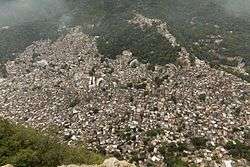 | |
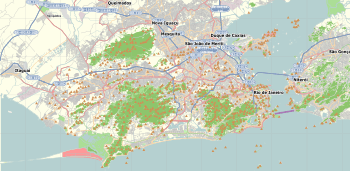 Rocinha Location in Rio de Janeiro  Rocinha Rocinha (Brazil) | |
| Coordinates: 22°59′19″S 43°14′54″W | |
| Country | |
| State | Rio de Janeiro (RJ) |
| Municipality/City | Rio de Janeiro |
| Zone | South Zone |
| Administrative Region | Rocinha |
| Area | |
| • Total | 143.72 ha (355.14 acres) |
| Population (2017)[1] | |
| • Total | 100,000 |
| • Density | 70,000/km2 (180,000/sq mi) |

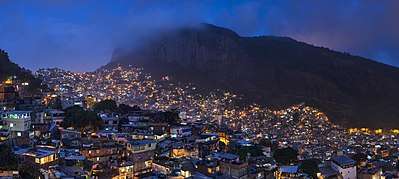
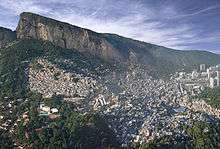
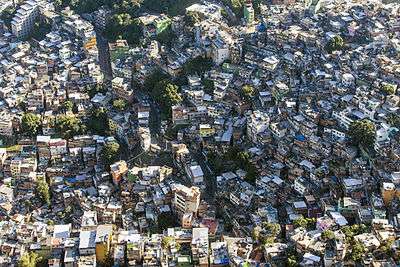
Although Rocinha is officially classified as a neighbourhood, many still refer to it as a favela. It developed from a shanty town into an urbanized slum. Today, almost all the houses in Rocinha are made from concrete and brick. Some buildings are three and four stories tall and almost all houses have basic sanitation, plumbing and electricity. Compared to simple shanty towns or slums, Rocinha has a better developed infrastructure and hundreds of businesses such as banks, medicine stores, bus routes, cable television, including locally based channel TV ROC (TV Rocinha), and, at one time, a McDonald's franchise.[4] These factors help classify Rocinha as a favela bairro, or favela neighborhood.
Community
There are a number of community organizations at work in Rocinha, including neighbourhood associations and numerous NGOs and non-profit educational and cultural institutions.[5][6] Rocinha is home to most of the service workers in Zona Sul (the South Zone of Rio).
In recent years, due to its relative safety in comparison to other favelas, Rocinha has developed tourism-oriented activities such as hostels, nightclubs and guided tours. In September 2017, between 150 and 600 tourists were estimated to visit the slum per day, despite foreign governments' and the Rio police's safety warnings recommending against it. In October 2017, a Spanish tourist died after being shot by the police while visiting Rocinha during a turf war.[7]
The slum is controlled by Amigos dos Amigos,[8] although it is often caught in violent disputes among (and within) different criminal organizations.[9][7]
Police and military operations
In November 2011, a security operation was undertaken where hundreds of police and military patrolled the streets of Rocinha to crack down on rampant drug dealers and bring government control to the neighbourhood.[10]
In December 2017, drug kingpin Rogério da Silva, known as Rogério 157, was arrested in Rocinha, in an operation involving 3,000 members of the Brazilian military and police forces. Rogério was wanted on charges of homicide, extortion, and drug trafficking.[11][12]
Rocinha is the largest favela in Brazil and one of the most developed.[13] Rocinha's population was estimated at between 150,000 and 300,000 inhabitants during the 2000s;[14] but the IBGE Census of 2010 counted only 69,161 people. In 2017, The Economist reported a population of 100,000 in an area of 1 km² (250 acres).[8]
In literature, film and music
Robert Neuwirth discusses Rocinha in his book entitled Shadow Cities.[15] Rio de Janeiro was made the setting for the animation film Rio, where many scenes take place in Rocinha.
Also, Rocinha is the setting of the book Nemesis: One Man and the Battle for Rio by Misha Glenny in which he describes the rise and fall of Antônio Francisco Bonfim Lopes.
In 1998, Philip Glass wrote an orchestral piece titled "Days and Nights in Rocinha". It was meant as a reference to Ravel's Bolero, written for Dennis Russell Davies, to thank him for putting Glass' works on stage. He was inspired by dance music that he heard during the carnival, resulting in a samba-like rhythmical structure with a lot of time signature changes and varieties, such as 14/8, 15/8 and 9/8+4/4.
In mass media and popular culture
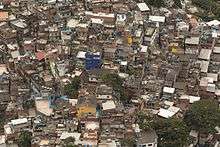
Many celebrities have visited Rocinha, including Mikhail Gorbachev (during the Earth Summit of 1992) and actor Christopher Lambert. Some episodes of the Brazilian television series Cidade dos Homens (City of Men) were filmed there.
The 2008 film The Incredible Hulk featured aerial footage of Rocinha, showing the large number of intermodal containers repurposed as housing.[16] It was also featured in the 2011 film Fast Five.
Video games
- In the 2009 video game Call of Duty: Modern Warfare 2, two of main campaign missions and a multiplayer map based on it are set in a Favela of Rio de Janeiro that closely resembles Rocinha.
- In the 2015 first-person shooter game Call of Duty: Black Ops III, Rocinha is mentioned as the hometown of the specialist Outrider.
- In the 2015 tactical first-person shooter game Tom Clancy's Rainbow Six Siege, a map called "Favela" is based on Rocinha.
See also
- Sérgio Cabral
- Rio de Janeiro
- Pacifying Police Unit
- Community policing
References
- "Bairro: Rocinha". Prefeitura do Rio de Janeiro. Retrieved 25 November 2014.
- Garcia, Janaina (21 December 2011). "Mais de 11 milhões vivem em favelas no Brasil, diz IBGE; maioria está na região Sudeste". UOL Notícias (in Portuguese). Retrieved 25 November 2014.
- http://lista10.org/diversos/as-10-maiores-favelas-do-brasil/
- Chetwynd, Gareth (2004-04-17). "Deadly setback for a model favela". The Guardian. London. Retrieved 2010-05-22.
- "Favela Community NGOs Fill the Gaps in Rio's Educational System". RioOnWatch. 17 November 2016. Retrieved 4 November 2017.
- "Rocinha / Organizações". www.riomaissocial.org (in Portuguese). Retrieved 4 November 2017.
- Kiernan, Paul (28 October 2017). "Rio Police Killing of Spaniard Spotlights Perils of Slum Tourism". Wall Street Journal. Retrieved 4 November 2017.
- "Rio's post-Olympic blues". The Economist. 5 October 2017.
- Glenny, Misha (25 September 2017). "One of Rio de Janeiro's Safest Favelas Descends Into Violence, the Latest Sign of a City in Chaos". The Intercept. Retrieved 4 November 2017.
- "Brazil police target drug gangs in Rio's biggest slum". BBC News. 13 November 2011. Retrieved 13 November 2011.
- Dom Phillips, Rio police hail arrest of drug kingpin in 3,000-strong favela operation, The Guardian (December 6, 2017).
- Dom Phillips & Júlio Carvalho, Arrest of Rio drug kingpin brings fear of power grab – and further violence, The Guardian (December 10, 2017).
- St. Louis, Regis; Draffen, Andrew (2005). Brazil (6 ed.). Lonely Planet. p. 139. ISBN 978-1-74104-021-0.
- Fodor's Brazil. Random House. 2008. p. 47.
- "Publishers Weekly review - Shadow Cities: A Billion Squatters, a New Urban World". Publishers Weekly. Retrieved 14 June 2012.
- "Filming locations for The Incredible Hulk". Internet Movie Database. Retrieved 3 November 2010.